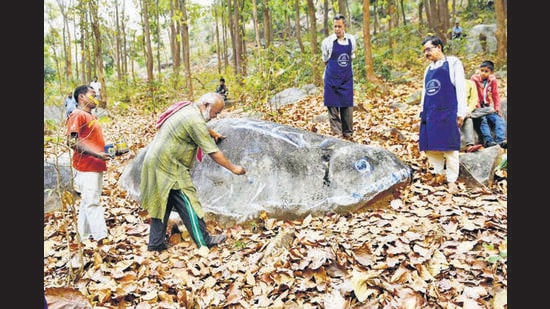Turtles, pangolins, anteaters and entire flocks of birds stand frozen in the Ajodhya hills of West Bengal. People come from miles away to see them. It makes their creator, artist Chitta Dey, very happy.
For 25 years, Dey, 65, has been carving, painting and etching on rock, creating tableaus across the forests of Purulia that reflect his love for nature. Over 200 rock faces bear his markings.
The smallest art work is 10 ft wide and the biggest, Pakhi Pahar (Bengali for Hill of Birds), is a dramatic spread of over 60 birds, sprawled across 4,800 sq ft. “The smallest bird there is about is about 55 ft wide and the biggest is over 120 ft wide,” says Dey.
His permanent outdoor gallery, located about 300 km northwest of Kolkata, has become a tourist attraction drawing people from across the state. Dey usually etches vulnerable species, as a way of honouring, documenting and spreading awareness about them. He also hopes that his art will deter stone smugglers from dynamiting these hills, in an area where such activity is sadly common.
As with so many wonderful things, Dey’s journey began with a failed attempt at something else. In the 1990s, he decided to create a massive sculpture of a flock of birds, spanning hundreds of feet. He knew he couldn’t use traditional materials such as metal, stone or terracotta. He’d learnt that the hard way, in 1991, when he turned up at an Academy of Fine Arts show in Kolkata with a 22-ft-long sheet-metal sculpture of a bird that wouldn’t fit through the doors. Dey had to literally clip the wings to get it through. And once inside, his creation still towered over the space.
His new design would be many times larger, so he knew he had to find an altogether different medium. “That’s when I started looking for rock faces,” Dey says. It would be an intriguing way of connecting his work with India’s most ancient art heritage — some of our ancient rock art, including those at Bhimbetka in Madhya Pradesh, is among the oldest in the world.

“We were doing it way back in the 10th century too. It can be seen in the caves of Ajanta and Ellora, and the temples at Mahabalipuram. Yet somehow, for a millennium after that, in situ rock carving came to a halt,” Dey says.
BIGGER AND BOULDER
Now that he’d decided on his medium, Dey had to find the right spot. He scoured hills across the country, from Maharashtra to Tamil Nadu, Madhya Pradesh and Odisha, before he was given permission and some funding by the West Bengal government in 1996, to execute his vision using the hills of Purulia.
He has trained and employed young men from local tribal communities as junior artists. “If the work is particularly big, then elaborate scaffolding and mountaineering harnesses are needed,” Dey says. Sometimes he uses a drill and other power tools for finishing touches, carrying a generator into places where electricity isn’t available.
After he conducted some drawing and painting workshops at Kolkata’s Alipore jail, some of the inmates there were brought to Purulia on two occasions too, to assist him.

Funding has been one of the biggest challenges, says Dey. It’s hard just to raise enough to pay his assistants. In the early 2000s, he received a grant from the Planning Commission. Since then he has depended mainly on private donations and funds from the sale of his own paintings and sculptures.
“It’s hard to say how long each piece takes, because I work on many simultaneously,” says Dey. “So I like to look at it as one big canvas that I’ve been working on for 25 years.”
Enjoy unlimited digital access with HT Premium
Subscribe Now to continue reading

Stay connected with us on social media platform for instant update click here to join our Twitter, & Facebook
We are now on Telegram. Click here to join our channel (@TechiUpdate) and stay updated with the latest Technology headlines.
For all the latest Art-Culture News Click Here
